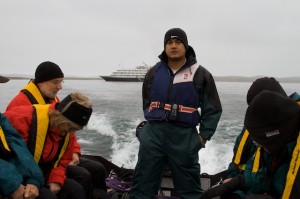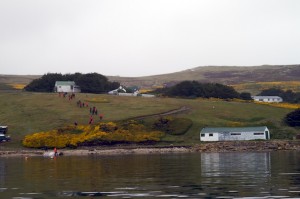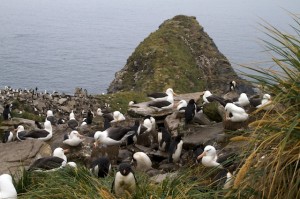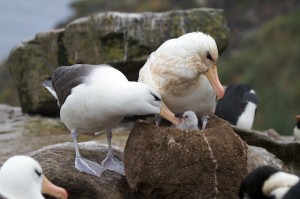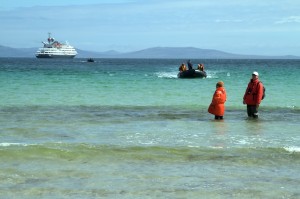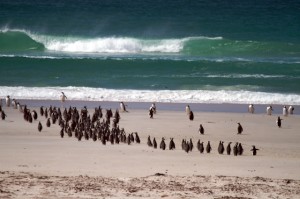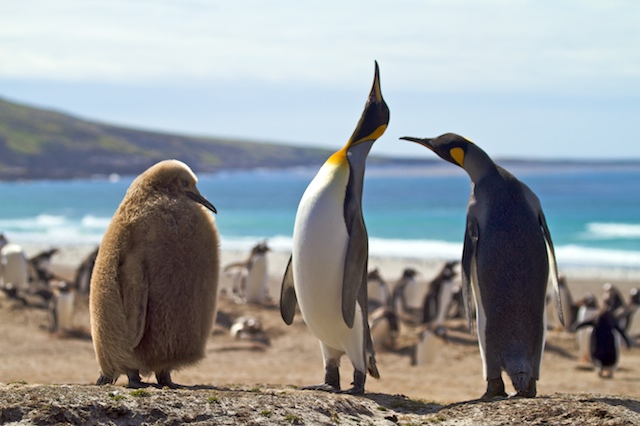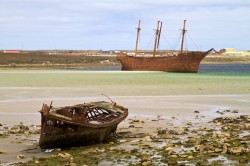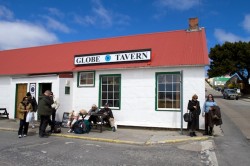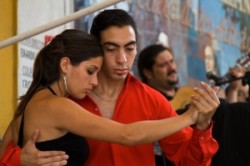A night and a day of sailing rolling seas brought us to the Falkland Islands. The first islands appeared on the northeastern horizon in the early light: relatively low and devoid of any trees. The climate is too harsh for them.
The Falklands, or Islas Malvinas as the Argentinians call them, are an archipelago of more than 700 separate islands lying east-southeast of the southern tip of South America. They are an Overseas Territory of the United Kingdom, which is responsible for their defense, a fact that became very real for Falklanders in 1982, when Argentina, which had also claimed the islands for over 150 years, invaded.
The resulting two month war brought casualties to both sides, British and Argentine. The Brits prevailed and the whole affair is still a sore point between everyone involved. Many parts of the islands still have land mines buried by the Argentines, though the more populated areas and sheep ranches have been cleared.
We made an early departure in our Zodiac landing craft into a protected cove to a small dock at a remote sheep ranch on West Point Island, owned by the Napier family. Their tidy little homestead is typical of other ranch operations in the islands — a small, white, wood-framed farmhouse, surrounded by a meticulous yard and white picket fence, and various out-buildings. Their only electric power is from a small wind turbine. Wind is a cheap commodity here.
But our main target was at the end of a mile and a half hike to the other side of the island: a large colony of nesting rockhopper penguins and black-browed albatross on a steep slope above the sea. The two species nest together among the tussock grass clumps, getting only mildly irritated when the other tries to pick its way through the maze of nests. We watched and photographed here for several hours before trudging back to the Napiers’ homestead where they had put up a great tea with all sorts of baked goods for us.
On the return, our zodiac was surrounded by playful and curious Comerson’s dolphins, small black and white dolphins with tiny, rounded dorsal fins.
Back on the ship, while eating lunch (not that we needed it after the Napiers!), the ship was repositioned a couple of hours away to Saunders Island. This is the largest of the Falkland Islands and the site of the first British settlement in 1765. Here in a narrow neck of land between two large hills we found colonies of Magellanic, gentoo, rockhopper and king penguins.
The beautiful king penguins are the second-largest of the penguins and we found a few here, along with their hilarious ‘little’ chicks. These young appear larger and fatter than the parents, mainly due to their thick, brown downy coats, making them look like they are dressed in oversized fur coats. With any luck, we’ll find thousands on South Georgia island, which we visit in a few days.
Tuesday, December 15, 2009
We cruised all night through rolling seas and anchored shortly after dawn in the bay at Port Stanley, the only city in the islands. Stanley was a major supply point for whalers, fishermen, and sealers over the last 200+ years.
I had been in Port Stanley more than 20 years ago and wasn’t prepared for the changes. With the popularity of Antarctic and southern ocean cruises, it has become a favored stopover for ships large and small. On the morning we arrived, we shared the town with 3,000 other passengers from a single cruise ship that was too large to anchor in the main harbor. The ship’s tenders took hours to shuttle the passengers into town. It effectively doubled the size of the town for the day!
While the main part of town was pretty much the same as when I was last here (except for the bulging crowds on the narrow sidewalks), the gold rush of money into town had fueled many new houses and apartments on the edges of town.
On my last visit, I was struck by the number of large 19th Century sailing vessels that lay stranded in the shallow bay, preserved by the cold air and water. Some with hulls of wood and some of iron, many with masts and rigging still intact, it was a veritable maritime museum. The wood ships that were too far gone had been converted into warehouses along the town’s shoreline.
Now most were gone, either rotted or refloated and taken to maritime museums in Britain and Maine, with the notable exception of the Lady Elizabeth at the far end of the bay. This large, three-masted schooner, some 250-300 feet in length was beached in a shallow inlet. She had suffered damage in rounding the Horn and limped into Port Stanley. Locals informed the crew that they didn’t have the resources to fix her, so she suffered the usual fate of end-of-the-line ships in Stanley — she became a warehouse. But in the 1930s a storm blew her to her current location.
A group of us took a very long walk along the far shore of the harbor, past a colony of nesting burrows of Magellanic penguins and pinnacles with nesting black-crowned night herons. We also skirted a gorgeous white-sand beach replete with warning signs about mines. It seemed that the Argentines thought this would be a great beach for the Brits to mount one of their assaults from the sea,
After lunch and a pint at the old Globe Pub on the waterfront, we wandered town a bit more and headed back to the ship. We weighed anchor around 5PM, cruised past the mega-ship in the outer harbor and into the heaving swell of the open ocean, bound for South Georgia Island, the whaling capital of the universe only 50 years ago, some two days and nights away.
As I write this, the waves are booming and crashing over the bow of our “tiny” 300-foot ship, while the 1500-foot long megaship can be seen in the late light on the northwestern horizon, headed back for the South American mainland.
We’re headed southeast, for more adventurous spots.
